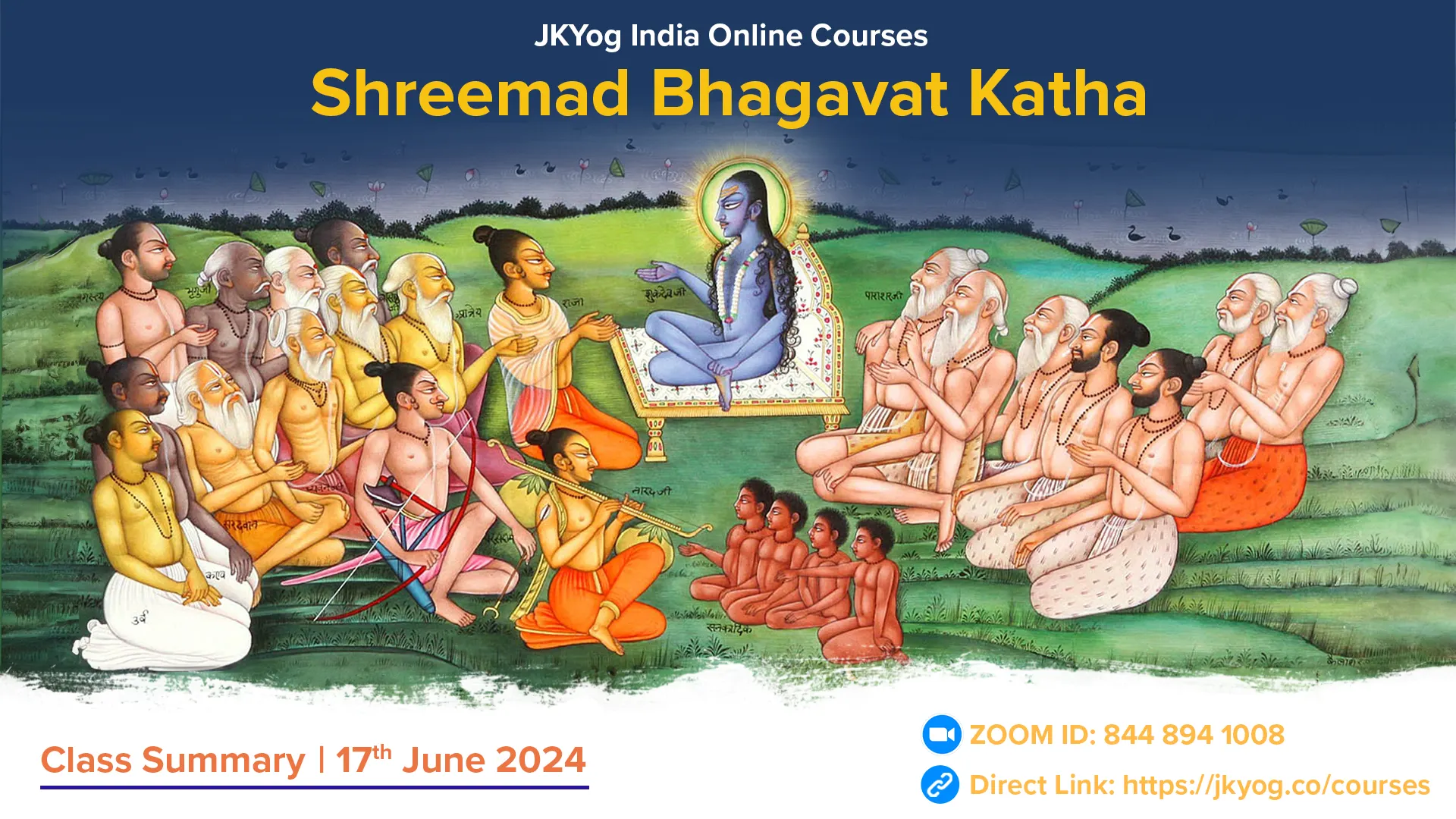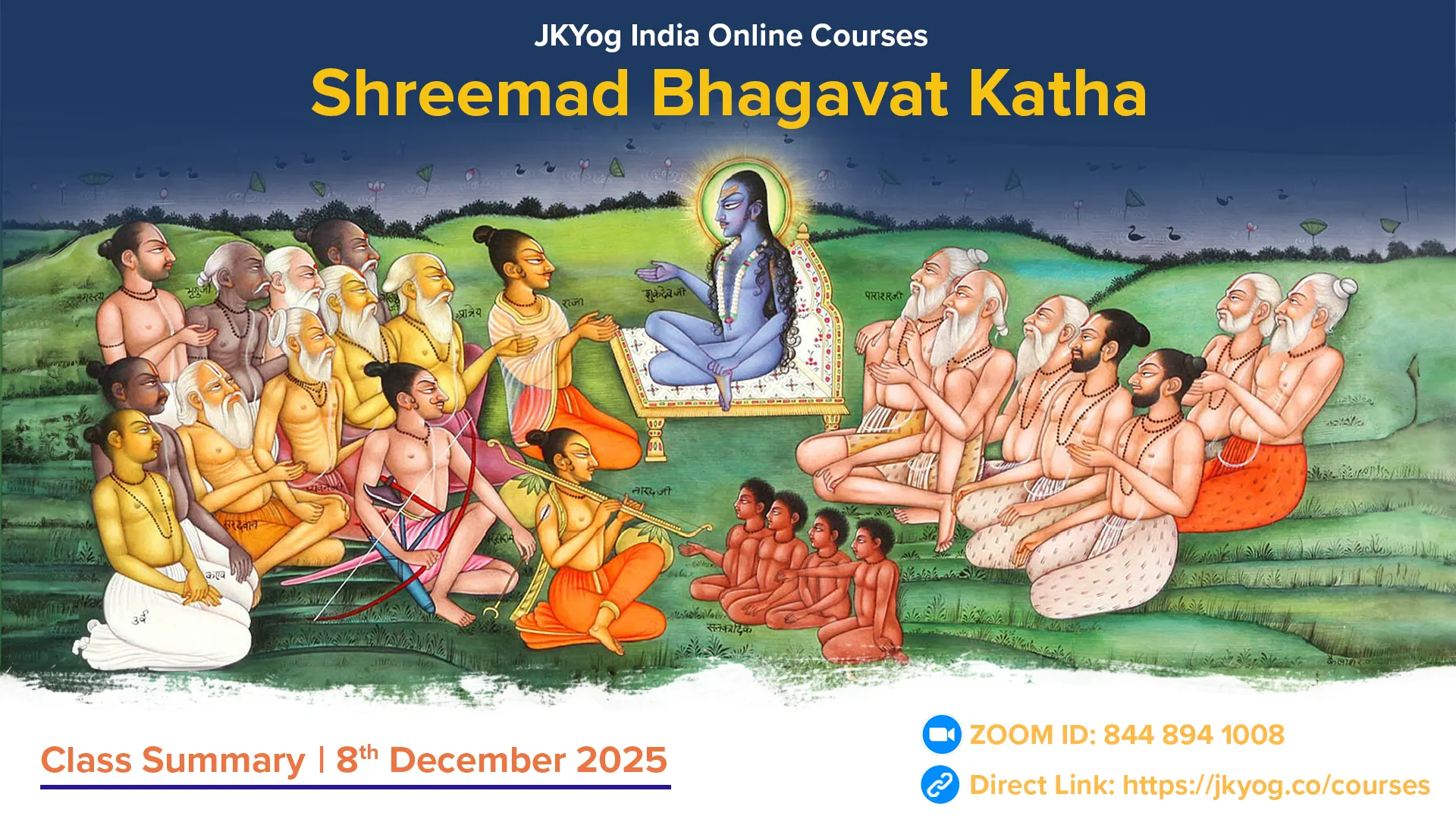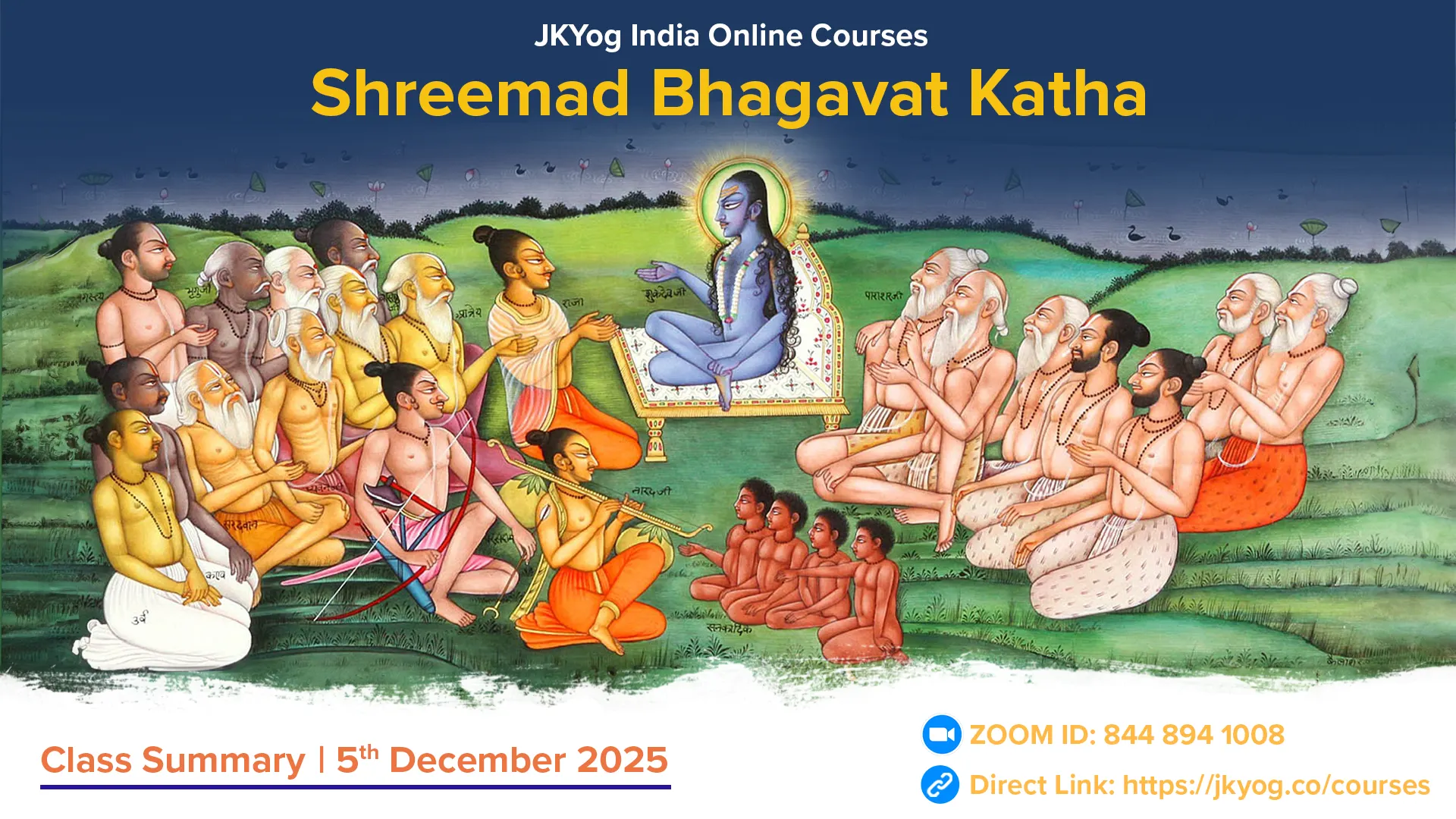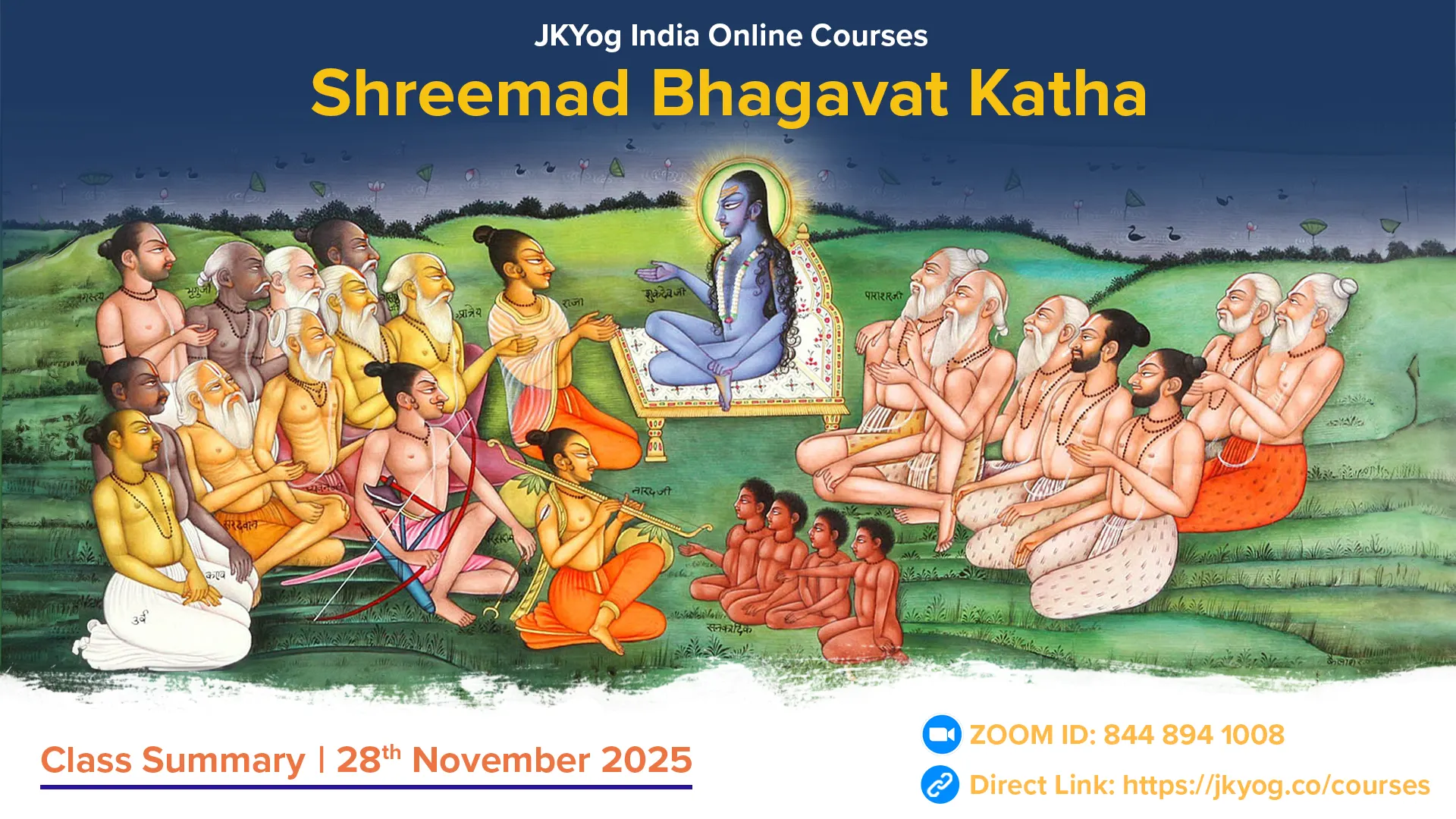Upon receiving instructions to perform a good deed to rescue Gyan and Vairagya from their suffering, Naradji embarks on a journey in search of a sage who can guide him on the meaning of this deed. Despite travelling to various places without success, he finally reaches Badrivanand, where he meets the Sanakadi Munis. Known as the four Manas Putras of Brahmaji - Sanak, Sanandan, Sanatan, and Sanatkumar - these great Yogis are wise and learned. Though they appear as five-year-old children, they are the ancestors of their ancestors. They permanently reside in Vaikunth Dham, constantly engrossed in Hari kirtan, savouring the nectar of God's Leela, and living solely for Bhagavat Katha. The mantra' Hari Sharanam' (God is our protector) is always on their lips, which shields them from the ravages of old age.
Naradji asks the Sanakadi Munis how Bhaktidevi and her two sons- Gyan and Vairagya, could be nourished. The sages reply that the rishis have shown many paths in the world for alleviating suffering, but all of them are arduous and result in attaining heaven. The path that leads to the realisation of God is still hidden, and one who reveals it is found only by fortune. They assure Nardaji that they will reveal the true indication of the Akashvani. The Sanakadi Munis further explain that there are four types of yagyas (yajña):
- Dravya yagya,
- Tapo yagya,
- Yog yagya and
- Gyan yagya
All these activities are considered to lead to attaining heaven and similar results. However, the wise believe that the Gyan-yagya (Jñāna-yajña/ ज्ञानयज्ञ) is the actual meritorious deed that leads to liberation. The Gyan-yagya involves reciting the Shreemad Bhagavatam, sung by great sages like Shuka. Just by listening to its words, Bhakti, Gyan, and Vairagya will gain great strength, and all their suffering will be removed, bringing joy to Bhaktidevi. Just as wolves flee upon hearing a lion's roar, similarly, the sound of the Shreemad Bhagavatam will destroy all the faults of the Kaliyug.
Naradji asks, "I have tried to awaken Gyan and Vairagya by reciting the Vedas, Vedanta, and Gita, but they did not awaken. In such a situation, how will they awaken by listening to the Shreemad Bhagavatam?"
Vedopanishadaam saraajjaata Bhagwati katha,
Atyuttamama tato bhaati prithagbhuta phalaakritih.
Sankadi says, "The story of the Shreemad Bhagavatam is composed of the essence of the Vedas and Upanishads. Therefore, it appears to be superior due to its fruitful nature, which sets it apart from them." (Bhagavat Mahatmya 1-2-67)
Just as every part of a tree, from its roots to its branches, contains sap, the actual flavour is only obtained by eating the fruit; and just as milk contains ghee, drinking milk does not provide the taste of ghee, and just as sugarcane contains sugar, but its sweetness is not experienced until the cane is crushed – the Bhagavata Katha is also like this. Sankadi says that Bhagavata Purana is equal to the Vedas. Ved Vyas wrote it to establish devotion, knowledge, and detachment. Earlier, when Ved Vyas was sad and was drowning in the sea of ignorance, Naradaji preached it to him in four verses. On hearing it, all his worries were dispelled. Sanakadi Munis says, "In such a situation, Naradaji, why do you have this question? You should narrate only Shreemad Bhagavata Purana, which destroys grief and sorrow."
Naradji says, "Great souls! Your presence instantly eradicates all the sins of a living being and swiftly brings peace to those scorched by the wildfire of worldly suffering. You constantly drink the nectar of the divine Leela katas (God's pastimes) sung by the thousand mouths of Shesha. I seek refuge in you intending to manifest Prem Bhakti (devotion characterised by love)."
Bhagyodayena bahujanma-samarjiten satsangam cha labhate purusho yadaa vai,
Ajnanahhetu-krita-mohamadha-andhakara nasham vidhaya hi tadodayate vivekah.
When the accumulation of virtuous deeds from countless previous lives comes to fruition, a person attains the company of sages. This dispels the darkness of ignorance, illusion, and pride and awakens discernment. (Bhagwat Mahatmya 1-2-76)
Janana-yajnam karishyami shukashastra-kathojjvalam,
Bhakti-jnana-viraganam sthapanartham prayatnatah.
Naradji says, "To establish Bhakti, Gyan, and Vairagya, I will now perform the Gyan-yajna through the glorious tale of the Shreemad Bhagavatam as narrated by Shukadev Ji." (Bhagavatam Mahatmya 1-3-1)
Naradji asks, "Where should this yagya be performed, and what is the method for listening to it?" The Sankadi Rishis informs him that one should organise the Bhagavat Katha Gyan-yagya at a ghat named Anand near Haridwar. The Bhagavat Katha has such an effect that the sons of Bhakti-Gyan and Vairagya will automatically become robust and youthful, free from old age. Wherever the Bhagavat Katha is held, Bhakti, Gyan, and Vairagya naturally arrive.
Naradji and Sanakadi all then reach the banks of the Ganga. Upon arrival, the news of Katha spreads across Bhulok, Devalok, and Brahmalok. Devotees who relish the essence of Bhagavat Katha rush to partake in its nectar. Sages like Bhrigu, Vasistha, Chyavan, Gautam, Medhatithi, Deval, Devarat, Parashurama, Vishwamitra, Shakal, Markandeya, Dattatreya, Pippalada, Yogeshwar Vyasa, and Parashara, along with Chhayashuk, Jajali, and Jakhnu, come with their sons, disciples, and women, filled with love. Besides them, the Vedas, Vedanta, Upanishads, mantras, tantras, seventeen Puranas, and six Shastras also come in personal form. The rivers like the Ganga, lakes like Pushkar, regions like Kurukshetra, all directions, forests like Dandaka, mountains like the Himalayas, gods, Gandharvas, and Danavas also come to listen to the Katha. Maharishi Bhrigu persuaded those who were hesitant due to their status and prestige.
The Sankadi Rishis sit on the excellent seat provided by Naradji to narrate the Katha. At that time, all the listeners pay their respects. Among the listeners are Vaishnavs, renunciates, sanyasis, and Brahmacharis, who are seated in the front, with Naradji sitting ahead of them. On one side are the sages, on another the gods, on another the Vedas and Upanishads, and on another side sit the tirthas, and the women sit on the other side. At that moment, cheers and the sound of conch shells fill the air, and a shower of abir, gulal, kheel, and flowers begins. On splendid aircraft, some gods shower the assembly with the Kalpavriksha flowers.
The Sankadi Rishis describe the glory of the Bhagavat Mahapuran to Naradji - This katha is the result of the virtuous deeds of many lifetimes. There are no strict rules for listening to it. It can be heard at any time. In Kaliyug, people cannot adhere to strict regulations for long periods, so a Saptah (week-long) method is used. What cannot be attained through yoga, penance, and meditation is gained by listening to the Bhagavat Katha. This yagya is superior to all yagyas, vratas, tirthas, and meditations.
When Shree Krishna was leaving this earth to go to Golok, He imparted knowledge to Uddhav. Uddhav asked, "After You leave, Kaliyug will come to earth. How will this earth bear its weight?" Shree Krishna then places all His power in the Bhagavat and enters into it. Thus, the Bhagavat is the God in the form of letters. Reading and listening to the Bhagavat washes away all sins. Every Yuga has its Yuga dharma through which a soul can attain salvation. Tapasya is the Yuga dharma of Satyayug, Yagya of Treta, and the worship of Dwapara. In Kaliyug, the Yuga dharma is the listening, reading, and reciting of the divine leelas of Shree Krishna, as written in Bhagavat. Otherwise, escaping God's Maya is difficult, even for the heavenly gods. How can humans escape it?
As the Sankadi Rishis describe the glory of the Bhagavat, Bhakti, pure love incarnate, appears with her two sons, repeatedly chanting the names of God, such as "Shree Krishna! Govinda! Hare! Murari! Hey Nath! Narayan! Vasudev!" She emerges from the essence of the Bhagavat Katha. Bhakti says, "The Kaliyug had nearly destroyed me, but You have revived me by making me drink the nectar of the Katha. Now, tell me, where should I reside?" The Sankadi Rishis reply, "You are the one who can grace the devotees the personal form (saguna sakar) of the God, bestows exclusive love and eradicates the worldly diseases; therefore, you should be patient and always reside in the hearts of the devotees. These defects of Kaliyug may affect the entire world, but their sight will not fall on you there."
Upon receiving their blessing, Bhakti immediately establishes herself in the hearts of the devotees. Those who have pure devotion to Shree Hari, even if they are extremely poor in the three worlds, are immensely blessed. This is because God Himself, bound by this devotion, enters their hearts. The Sankadi Rishis say that in Bhulok, the Bhagavat is the very form of the Parabrahman. How far can we describe its glory? Taking shelter in it, both the listener and the narrator of the Katha gain the devotion, love, and divine service of Bhagawan Shree Krishna.
Upon witnessing the emergence of Bhakti, Shree Krishna Himself appears there. Seeing His wondrous form, everyone chants, "Jai, Jai!" No one is aware of themselves. Naradji says, "In Kaliyug, undoubtedly, there is no other means of welfare like the Bhagavat Katha. Now, Please tell us, who all gets purified by listening to it?" The Sankadi Rishis then narrate the stories of Atmadev, Gokarna, and Dhundhukari.
Summary: JKYog India Online Class- Shreemad Bhagavat Katha [Hindi]- 17.06.2024
Summary: JKYog India Online Class- Shreemad Bhagavat Katha [Hindi]- 17.06.2024









What our Participants say